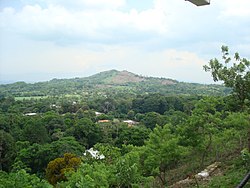Cabañas Department
| Cabañas | ||
|---|---|---|
| Department | ||
 |
||
|
||
 Location within El Salvador |
||
| Coordinates: 13°53′49″N 88°42′32″W / 13.897°N 88.709°WCoordinates: 13°53′49″N 88°42′32″W / 13.897°N 88.709°W | ||
| Country |
|
|
| Created | 1873 | |
| Seat | Sensuntepeque | |
| Area | ||
| • Total | 1,103.5 km2 (426.1 sq mi) | |
| Area rank | Ranked 12th | |
| Highest elevation | 1,014 m (3,327 ft) | |
| Lowest elevation | 50 m (160 ft) | |
| Population | ||
| • Total | 164,945 | |
| • Rank | Ranked 14th | |
| • Density | 150/km2 (390/sq mi) | |
| Time zone | CST (UTC−6) | |
| ISO 3166 code | SV-CA | |
Cabañas is a department of El Salvador in the north central part of the country. Its capital is Sensuntepeque and it is one of coolest parts of El Salvador. Classified as a department in February 1873, it covers an area of 1,103.5 km2 (426.1 sq mi) and has over 164,900 inhabitants. The other major city of the department is Ilobasco. Agricultural produce includes coffee, sugar cane and sesame seeds, as well as dairy products. Gold, silver and copper are the principal minerals mined in the department. Its main industrial activity is oriented to manufacture of potteries, cheese, lime and also distilleries.
The department takes its name from the Central-American hero General José Trinidad Cabañas who in later life served as a minister in El Salvador. From the early 18th century, the town of Ilobasco, one of the oldest pottery centres of El Salvador, attracted Creole and Spanish inhabitants (many of Cuban origin) from the rest of the country. The blue dye indigo has also been produced there in substantial quantities since at least 1735.
By the beginning of the 19th century, Ilobasco was a thriving community with the establishment of markets, pharmacies, blacksmiths and saddlers. Tourists have recently been attracted to Ilobasco where clay dolls and other types of pottery are a major attraction in addition to a lakeside recreation area. By the early 20th century, the department had two cities, Sensuntepeque and Ilobasco, as well as five towns, Victoria, Dolores, San Isidro, Jutiapa, and Tejutepeque. The Flag of the Cabañas Department is made up of blue-red colours painted vertically and separated by a S-like wavy white line.
Cabañas Department is located in the northern centre of the country, bordered on the north by the Chalatenango Department, to the northeast by Honduras, on the east by the San Miguel Department, to the south by the San Vicente Department, and to the west by the Cuscatlan Department. Of note is the 88 kilometres (55 mi) long Lempa River (88 kilometres (55 mi)), reservoirs of the Cerrón Grande hydroelectric dam, the La Cruz hills (921 metres (3,022 ft)) and the Ocotillo (1,014 metres (3,327 ft)). The department includes parts of the highland district of Cojutepeque and shares a border with the plateau district in the west. Small streams drain from the Jiboa River, Titihuapa River, and Acahuapa River, while others drain to the Lempa River. Most of the area consists of mountain ranges and chains, though the eastern and northern parts of the Department are desolate. There are also fertile valleys, which produce agricultural crops such as indigo, rice, corn, and many other grains.
...
Wikipedia

